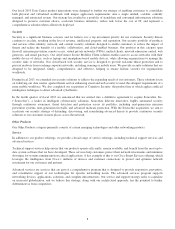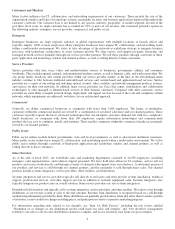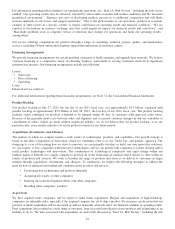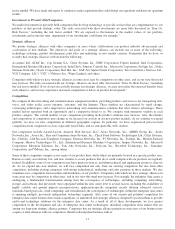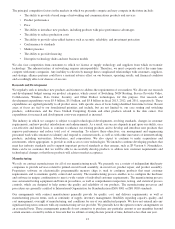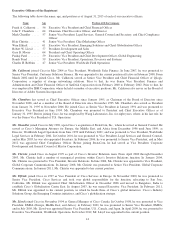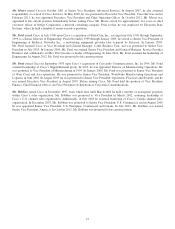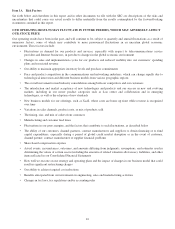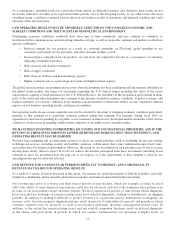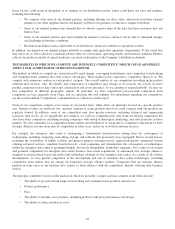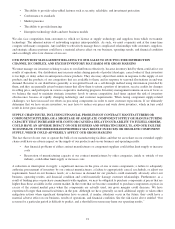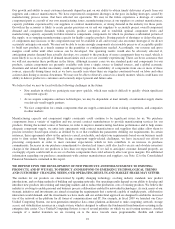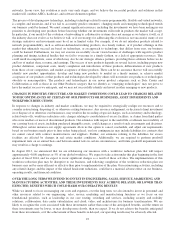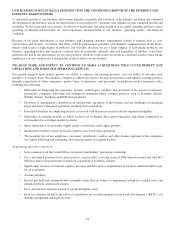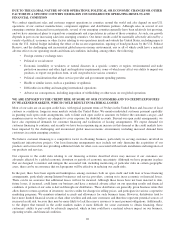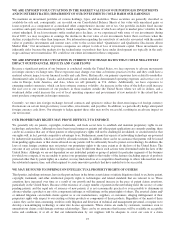Cisco 2013 Annual Report Download - page 25
Download and view the complete annual report
Please find page 25 of the 2013 Cisco annual report below. You can navigate through the pages in the report by either clicking on the pages listed below, or by using the keyword search tool below to find specific information within the annual report.As a consequence, operating results for a particular future period are difficult to predict, and, therefore, prior results are not
necessarily indicative of results to be expected in future periods. Any of the foregoing factors, or any other factors discussed
elsewhere herein, could have a material adverse effect on our business, results of operations, and financial condition that could
adversely affect our stock price.
OUR OPERATING RESULTS MAY BE ADVERSELY AFFECTED BY UNFAVORABLE ECONOMIC AND
MARKET CONDITIONS AND THE UNCERTAIN GEOPOLITICAL ENVIRONMENT
Challenging economic conditions worldwide have from time to time contributed, and may continue to contribute, to
slowdowns in the communications and networking industries at large, as well as in specific segments and markets in which we
operate, resulting in:
• Reduced demand for our products as a result of continued constraints on IT-related capital spending by our
customers, particularly service providers, and other customer markets as well
• Increased price competition for our products, not only from our competitors but also as a consequence of customers
disposing of unutilized products
• Risk of excess and obsolete inventories
• Risk of supply constraints
• Risk of excess facilities and manufacturing capacity
• Higher overhead costs as a percentage of revenue and higher interest expense
The global macroeconomic environment and recovery from the downturn has been challenging and inconsistent. Instability in
the global credit markets, the impact of uncertainty regarding the U.S. federal budget including the effect of the recent
sequestration, tapering of bond purchases by the U.S. Federal Reserve, the instability in the geopolitical environment in many
parts of the world and other disruptions may continue to put pressure on global economic conditions. If global economic and
market conditions, or economic conditions in key markets, remain uncertain or deteriorate further, we may experience material
impacts on our business, operating results, and financial condition.
Our operating results in one or more segments may also be affected by uncertain or changing economic conditions particularly
germane to that segment or to particular customer markets within that segment. For example, during fiscal 2011 we
experienced a decrease in spending by our public sector customers in almost every developed market around the world, and we
continue to see decreases in spending within certain categories of our public sector customer market.
WE HAVE BEEN INVESTING IN PRIORITIES, INCLUDING OUR FOUNDATIONAL PRIORITIES, AND IF THE
RETURN ON THESE INVESTMENTS IS LOWER OR DEVELOPS MORE SLOWLY THAN WE EXPECT, OUR
OPERATING RESULTS MAY BE HARMED
We have been realigning and are dedicating resources to focus on certain priorities, such as leadership in our core routing,
switching and services, including security and mobility solutions; collaboration; data center virtualization and cloud; video;
and architectures for business transformation. However, the return on our investments in such priorities may be lower, or may
develop more slowly, than we expect. If we do not achieve the benefits anticipated from these investments (including if our
selection of areas for investment does not play out as we expect), or if the achievement of these benefits is delayed, our
operating results may be adversely affected.
OUR REVENUE FOR A PARTICULAR PERIOD IS DIFFICULT TO PREDICT, AND A SHORTFALL IN
REVENUE MAY HARM OUR OPERATING RESULTS
As a result of a variety of factors discussed in this report, our revenue for a particular quarter is difficult to predict, especially
in light of a challenging and inconsistent global macroeconomic environment and related market uncertainty.
Our revenue may grow at a slower rate than in past periods or may decline, which for example occurred in fiscal
2009. Our ability to meet financial expectations could also be adversely affected if the nonlinear sales pattern seen
in some of our past quarters recurs in future periods. We have experienced periods of time during which shipments
have exceeded net bookings or manufacturing issues have delayed shipments, leading to nonlinearity in shipping
patterns. In addition to making it difficult to predict revenue for a particular period, nonlinearity in shipping can
increase costs, because irregular shipment patterns result in periods of underutilized capacity and periods in which
overtime expenses may be incurred, as well as in potential additional inventory management-related costs. In
addition, to the extent that manufacturing issues and any related component shortages result in delayed shipments
in the future, and particularly in periods in which our contract manufacturers are operating at higher levels of
17



